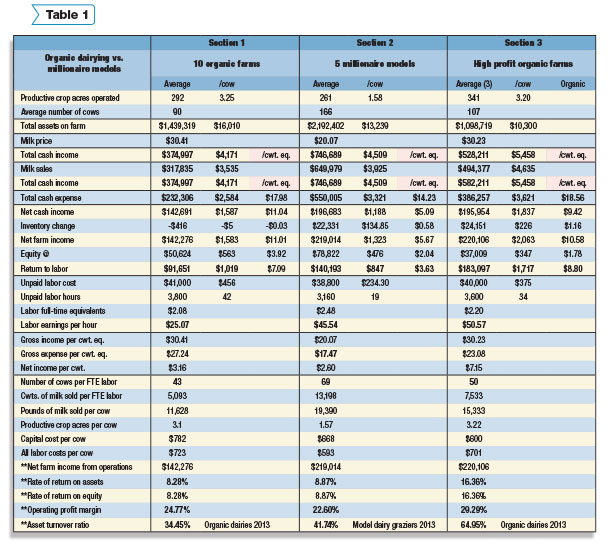A financial study analyzed 2103 data from five millionaire model dairy farms (MMDF) and 10 organic dairy farms (ODF). These farms are located in northeast Iowa, southwest Wisconsin or northwest Illinois. The farms may or may not be representative of the industry because in both groups the farms were selected based on their willingness to supply data or familiarity by extension personnel.
MMDF is an Iowa State University Extension project designed to instill inspiration into beginning and transitioning dairy farmers to utilize labor, assets and management skills to become millionaires over a 25-year period.
The MMDF system has a base of milking 80 cows on 80 acres with one full-time labor equivalent. The system is a hybrid system, using the best management practices of the confinement dairy world married with the best management practices of the grazing world.
The model is focused on labor efficiency using low-cost TRANS Iowa milking parlors and labor-efficient grazing, housing and manure management techniques. In addition, they focus on financial efficiency using the Dairy TRANS financial analysis program while maintaining a good quality of life.
Editor's note: Visit Iowa State Extension's website on milking systems for more information about TRANS Iowa parlors.
The ODF in many respects were found to use many similar management practices but employ fewer cows and people with less milk production per cow and a significantly lower level of milk production per full-time labor equivalent.
Note that this study was done without inquiring of the debt structure for the farms. Thus, the interest expense does not show up as a cash expense, so total cash expenses are before interest.
Also, the principal payments are not included in the cash-flow portion of the study. (The cash-flow portion is not included in this article.) Instead, an equity charge (3.5 percent) is taken against all the farm assets. This allows a better comparison of farms and reduces profit variability among farms due to varying debt loads.
So which system is more profitable?
To answer that question, first realize that both of the datasets are very small to make a definitive statement. Second, there are some farms in each dataset that are higher in profitability than the other dataset, and some that are lower in profitability. And third, realize this was data from only one year, and the conventional milk price can swing significantly from year to year.
With that in mind, the average ODF had 90 cows on 292 acres, or 3.25 acres per cow. The average MMDF had 166 cows on 261 acres, or 1.58 acres per cow. The average ODF received $30.41 per hundredweight (cwt) milk price while the MMDF received $20.07 (52 percent increase). The average total investment on the ODF was $16,010 per cow compared to the MMDF at $13,239 per cow.
Net farm income (after adjustment for inventory changes during the year) for the ODF averaged $1,583 per cow and $1,323 per cow for the MMDF (20 percent more). After an equity charge of $563 per cwt and $476 per cow for the ODF and MMDF, respectively, the ODF had a return to unpaid labor of $1,019 per cow, and the MMDF had a return to unpaid labor of $847 per cow.
If the return to unpaid labor was divided by the unpaid labor hours, the average ODF earned $25.07 per hour and the average MMDF earned $45.54 per hour.
With gross incomes per cwt equivalent of $30.41 and $20.07, respectively, for the ODF and MMDF, gross expenses per cwt equivalent were $27.24 and $17.47, respectively. Thus, net income per cwt equivalent was $3.16 for the ODF and $2.60 for the MMDF.
The average ODF had 43 cows per full-time equivalent (FTE), while the average MMDF had 69 cows per FTE. Other data, such as efficiencies per cow, can be found in Table 1 along with some financial ratios.
The profitability of the “average” group varied greatly. So, Section 3 of Table 1 includes the top three high-profit ODF. Note that this data beats the MMDF data in most respects in profitability. Also note, this is only one year of data, and the conventional milk price has large price swings.

The organic price is much more stable. In 2013, the most profitable ODF in the study competed very well with the most profitable MMDF in the study. It was interesting to note that there was a medium-profit group in the organic study where three of the four farms had herd averages between 8,000 and 9,000 pounds.
There is a lot of variability in the organic dairy dataset, as there is a lot of variability in the dairy industry itself. Based on the data of both the ODF and the MMDF, it is recognized the management behind the system may be more important than the system itself. Yet if done right, ODF has significant profit potential.
Again, remember, this is one year’s worth of data. The increase in conventional milk prices in 2014 relative to organic milk prices would change this analysis substantially. Over years of study, the organic milk price benefits by reducing variability and risk. PD
For more information on this study, visit the Iowa State University website.

Larry Tranel
Extension Dairy Specialist
Iowa State University




